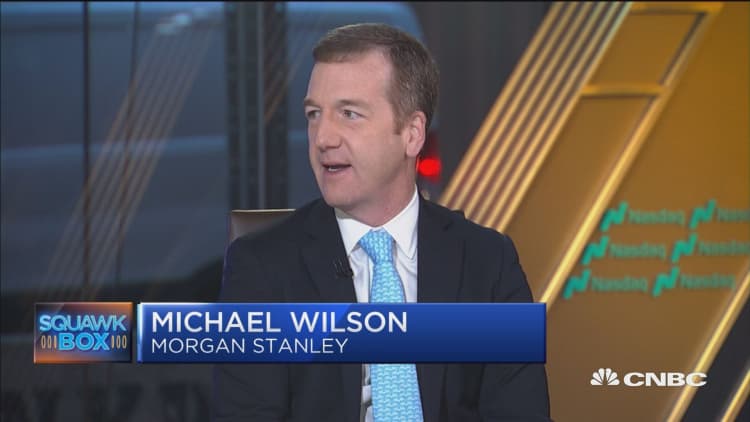
Morgan Stanley is warning investors to be careful when picking stocks next year because paying too much for overhyped growth names could be disastrous.
Mike Wilson, chief U.S. equity strategist at the firm, sees an "earnings recession" at some point in 2019, predicting "two quarters of negative year-over-year growth." The second and third quarters are at the greatest risk for three reasons, he explained Tuesday on CNBC's "Squawk Box." "The comparisons are very difficult. And you're going to have a massive deceleration in economic growth; not a recession but a deceleration." He's also worried about "margin pressure."
Wilson and Morgan Stanley at the end October, as the was turning in its worst monthly losses in about seven years, broke with many strategists and firms who believed the market rout would be short-lived. At the time, Wilson wrote in a note, "The rolling bear market continues to make progress and there is growing evidence that it is morphing into a proper cyclical bear market." He was defining a "bear market" in terms of many stocks down 20 percent from recent highs, not the indexes.
Tuesday on CNBC, Wilson stood by that outlook. "There will definitely be panic on individual securities next year, which is why we think you got to be very careful about overpriced stocks. That's where we think the risk remains, in the high-priced growth stocks — not growth overall — but high-priced growth stocks where expectations are too high, they're going to be punished severely."
However, he said, "As part of our rolling bear market theme, it's going to be a very unsatisfying bear market to the bears. Why? Because you're in a structural bull market. And when you're in a structural bull market you don't get the big earnings collapse."
Heading into the new year, two major concerns on Wall Street were defused and the stock market jumped.
First, on trade, the weekend meeting between President Donald Trump and Chinese leader Xi Jinping produced an agreement to halt any further tariffs on each other's goods while talks continue.
Second, on interest rates, Federal Reserve Chairman Jerome Powell walked back his long-way-from-neutral comments that slammed the markets in October and into November. Last week, he said rates are just below neutral, suggesting that concerns about a more aggressive path higher for rates may no longer be warranted. His Wednesday remarks fueled a market turnaround that put November modestly in the green.
The Fed later this month is expected to raise rates for the fourth time this year. But the path next year is up for debate. After its September rate hike, the Fed projected three rate increases into 2019. The current target range for the central bank's benchmark federal funds rate, which banks charge each other for overnight lending, stands at 2 percent to 2.25 percent.
Despite the Fed and the trade detentes, Morgan Stanley's Wilson said Tuedsay on CNBC that he has not adjusted his near-term trading range for the S&P 500 of between 2,650 and 2,825. For 2019, he sees a base case of 2,750 for the index, a bear case of 2,400, and a bull case of 3,000.
The S&P 500 on Monday jumped 1 percent on the Trump-Xi trade cease-fire, closing at 2,790.


